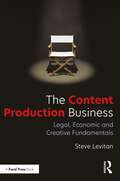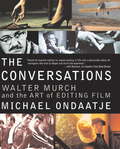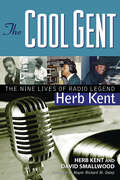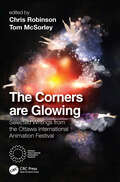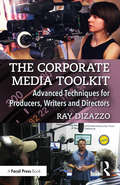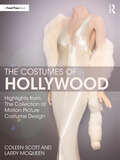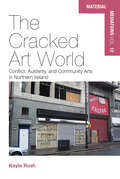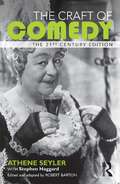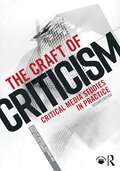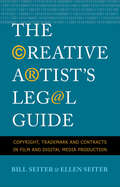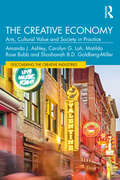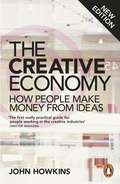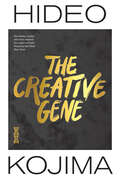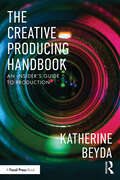- Table View
- List View
The Content Production Business: Legal, Economic and Creative Basics for Producers
by Steve LevitanThis book goes beyond the technical steps in the process of making film, TV, and media material, examining what it means to be an ongoing supplier of content to the marketplace and how to become one. Steve Levitan brings insights and experience from his lifelong career producing in the content industry, where he has also acted as a professional advisor to content makers, distributors and providers, whilst setting up his own production company. Producing as a Business offers strategic, tactical, financial, legal and marketing insights for the successful establishment of content creation enterprises. Readers will gain insight into how to avoid starting from square one with each project, while also learning how to maintain a meaningful level of ownership and build a revenue stream that can sustain a core operation, helping establish them as a “player” in the industry. This text is aimed at the international production industry, with real examples referred to throughout. Film, television, and media production students who are looking to understandthe business of producing, as well as first-time producers who are already familiar with the basics of the production process, will benefit from an examination of the building blocks that form lasting production companies.
The Conversations: Walter Murch and the Art of the Editing Film
by Michael OndaatjeThe Conversationsis a treasure, essential for any lover or student of film, and a rare, intimate glimpse into the worlds of two accomplished artists who share a great passion for film and storytelling, and whose knowledge and love of the crafts of writing and film shine through. It was on the set of the movie adaptation of his Booker Prize-winning novel, The English Patient, that Michael Ondaatje met the master film and sound editor Walter Murch, and the two began a remarkable personal conversation about the making of films and books in our time that continued over two years. From those conversations stemmed this enlightened, affectionate book -- a mine of wonderful, surprising observations and information about editing, writing and literature, music and sound, the I-Ching, dreams, art and history. The Conversationsis filled with stories about how some of the most important movies of the last thirty years were made and about the people who brought them to the screen. It traces the artistic growth of Murch, as well as his friends and contemporaries -- including directors such as Francis Ford Coppola, George Lucas, Fred Zinneman and Anthony Minghella -- from the creation of the independent, anti-Hollywood Zoetrope by a handful of brilliant, bearded young men to the recent triumph of Apocalypse Now Redux. Among the films Murch has worked on are American Graffiti, The Conversation, the remake of A Touch of Evil, Julia, Apocalypse Now, The Godfather(all three), The Talented Mr. Ripley, and The English Patient. “Walter Murch is a true oddity in Hollywood. A genuine intellectual and renaissance man who appears wise and private at the centre of various temporary storms to do with film making and his whole generation of filmmakers. He knows, probably, where a lot of the bodies are buried. ”
The Conversations: Walter Murch and the Art of the Editing Film
by Michael OndaatjeThe Conversations is a treasure, essential for any lover or student of film, and a rare, intimate glimpse into the worlds of two accomplished artists who share a great passion for film and storytelling, and whose knowledge and love of the crafts of writing and film shine through. It was on the set of the movie adaptation of his Booker Prize-winning novel, The English Patient, that Michael Ondaatje met the master film and sound editor Walter Murch, and the two began a remarkable personal conversation about the making of films and books in our time that continued over two years. From those conversations stemmed this enlightened, affectionate book -- a mine of wonderful, surprising observations and information about editing, writing and literature, music and sound, the I-Ching, dreams, art and history. The Conversations is filled with stories about how some of the most important movies of the last thirty years were made and about the people who brought them to the screen. It traces the artistic growth of Murch, as well as his friends and contemporaries -- including directors such as Francis Ford Coppola, George Lucas, Fred Zinneman and Anthony Minghella -- from the creation of the independent, anti-Hollywood Zoetrope by a handful of brilliant, bearded young men to the recent triumph of Apocalypse Now Redux. Among the films Murch has worked on are American Graffiti, The Conversation, the remake of A Touch of Evil, Julia, Apocalypse Now, The Godfather (all three), The Talented Mr. Ripley, and The English Patient. "Walter Murch is a true oddity in Hollywood. A genuine intellectual and renaissance man who appears wise and private at the centre of various temporary storms to do with film making and his whole generation of filmmakers. He knows, probably, where a lot of the bodies are buried."From the Trade Paperback edition.
The Cookie Company
by Ross VenokurWhen the unluckiest boy in the world turns thirteen, even more bad luck is sure to follow. So when a mysterious Chinese-food deliveryman appears on Alex Grindlay’s doorstep with a surprise birthday dinner, Alex knows better than to expect a good fortune in his fortune cookie dessert. But even Alex couldn’t have predicted the crazy adventures that lie ahead of him. Just his luck: One little fortune cookie changes his life forever. Alex is whisked into a world where anything can happen, and the fortune in his cookie is his only clue to the route home. As if that isn’t bad enough, he’s pursued relentlessly by Cypress Vine, an evil game show host who wants to take over Alex’s world. All she needs is a way to get out of her world and into his--and a magical cookie will do the trick nicely. With all his bad luck, how on earth can Alex stop a superpowerful game show host? He’d better figure it out soon if he ever wants to get home.
The Cool Gent: The Nine Lives of Radio Legend Herb Kent
by David Smallwood Herb Kent Mayor Richard M. DaleyWhen Herb Kent was a straight-A college student in the 1940s, his white professor told him, “You have the best voice in class, but you'll never make it in radio because you're a Negro.” This did not deter the poor kid from the Chicago housing projects who had decided on a radio career at age five. It was just one more obstacle to face head on and overcome. Known as the Cool Gent, the King of the Dusties, and the Mayor of Bronzeville, Herb Kent is one of radio's most illustrious and legendary stars. This fascinating autobiography details both the high and low points of Herb's life while providing a vivid picture of black music, culture, and personalities from the 1950s to today. Herb had a typical rock-and-roll lifestyle—drugs, alcohol, all-night partying, and women—eventually hitting rock bottom, where he finally faced his personal demons. At least nine times Herb came close to death, but through it all, he maintained his debonair, classy persona and his uncanny knack for picking timeless tunes. And he didn't save only himself; along the way, he blazed new trails for all African Americans and remains a role model for today's top deejays.
The Cool and the Crazy: Pop Fifties Cinema
by Professor Peter StanfieldExplosive! Amazing! Terrifying! You won't believe your eyes! Such movie taglines were common in the 1950s, as Hollywood churned out a variety of low-budget pictures that were sold on the basis of their sensational content and topicality. While a few of these movies have since become canonized by film fans and critics, a number of the era's biggest fads have now faded into obscurity. The Cool and the Crazy examines seven of these film cycles, including short-lived trends like boxing movies, war pictures, and social problem films detailing the sordid and violent life of teenagers, as well as uniquely 1950s takes on established genres like the gangster picture. Peter Stanfield reveals how Hollywood sought to capitalize upon current events, moral panics, and popular fads, making movies that were "ripped from the headlines" on everything from the Korean War to rock and roll. As he offers careful readings of several key films, he also considers the broader historical and commercial contexts in which these films were produced, marketed, and exhibited. In the process, Stanfield uncovers surprising synergies between Hollywood and other arenas of popular culture, like the ways that the fashion trend for blue jeans influenced the 1950s Western. Delivering sharp critical insights in jazzy, accessible prose, The Cool and the Crazy offers an appreciation of cinema as a "pop" medium, unabashedly derivative, faddish, and ephemeral. By studying these long-burst bubbles of 1950s "pop," Stanfield reveals something new about what films do and the pleasures they provide.
The Corners are Glowing: Selected Writings from the Ottawa International Animation Festival
by Chris Robinson & Tom McSorleyThe Ottawa International Animation Festival (OIAF) began in 1976 and stands today as one of the oldest and largest animation events in the world. One of the unique features of the OIAF is the inclusion of commissioned writings that provide attendees with a more in-depth background into the festival’s special screenings. These writings have not only contextualized the festival presentations but have also contributed significantly to animation education and scholarship. The Corners are Glowing is a selection of the best writings (many unseen for decades) culled from past OIAF catalogues. These wide-ranging texts cover the spectrum of animation from the familiar (Daffy Duck, Pee Wee Herman, Bob Clampett, Joanna Quinn, Hiyao Miyazaki, Frank Tashlin) to the more esoteric (Robert Breer, Emily Pelstring, Taku Furukawa, Michael Sporn, and even the use of furniture in animation!). The Corners are Glowing is a valuable time capsule that celebrates animation’s past and present, and the styles of writing are as diverse, enlightening, and fun as the animation subjects being written about.
The Corporate Media Toolkit: Advanced Techniques for Producers, Writers and Directors
by Ray DiZazzoThis book offers corporate writers, producers and directors an accessibly-written, hands-on guide to practical techniques important in producing high-quality, nuanced work in a corporate environment. Exploring each phase of media development—project inception, client interactions, scriptwriting, preproduction, casting, auditions, production and postproduction—author Ray DiZazzo teaches readers how to "know what works" in corporate media, as well as an ability to focus on the nuance and subtleties that elevate typical media to a higher quality standard, whether it’s crafting an intelligent script, framing and lighting a shot correctly, or knowing what transition to use in the editing suite. The book also features case studies illustrating real-life scenarios from the author and other corporate professionals, demonstrating these crucial techniques in practice. The Corporate Media Toolkit is a must-read for professionals and newcomers alike to bring their corporate media skills to the next level.
The Costume Designer's Toolkit: The Process of Creating Effective Design (The Focal Press Toolkit Series)
by Holly Poe DurbinThe Costume Designer’s Toolkit explores the wide-ranging skills required to design costumes for live performance in theatre, dance, opera, and themed entertainment. Arranged in chronological order to create a design, each chapter describes tools, strategies, and techniques costume designers use to create lively and believable characters within a story environment. The book provides a step-by-step outline of the costume design process beginning with developing as an artist and creating an artistic vision for a script. It covers a wide range of topics, including: Assessing the scope of a production Understanding design thinking and the creative process Project management and budget forecasting Collaborating with and leading creative teams Current practices in costume rendering and communication Mixing purchased, rented, stock, and built costumes to form a design Designing a garment with impact Fitting costumes on performers Combining grit and grace for a successful career Each topic includes case studies and tips from experienced professionals, identifies vital skills, describes techniques, and reveals the essential elements of artistic leadership, collaboration, and cultural acumen. The Costume Designer’s Toolkit is the perfect guidebook for the student, aspiring, or early-career costume designer, to be used alone or in costume design university courses.
The Costumes of Burlesque: 1866-2018
by Coleen ScottThe Costumes of Burlesque: 1866-2018 is the first volume to inclusively document burlesque costume from its birth in the 1860’s through the global burlesque movement in 2018. This lushly illustrated book presents the history and development of this American art form by documenting the origins, influencers, and genuine articles that created its aesthetic. Showcases of legendary performers, including Lydia Thompson, Gypsy Rose Lee, Sally Rand, Bettie Page, Kitten Natividad, and Dita Von Teese, demonstrate costume styles through the years. This guide gives readers a clear view of how burlesque costume looked and why. It teaches collectors, burlesque performers, and fans alike to recognize vintage pieces for what they are and to design their own costumes with inspiration from the originals. By including detailed costume documentation, over 400 images, and interviews with prominent costume designers such as Catherine D’Lish and Garo Sparo, The Costumes of Burlesque brings 150 years of burlesque costume history to life.
The Costumes of Downton Abbey
by Emma MarriottAn inside look at the intricate costuming of the popular PBS series, including character costume choices and the historic fashion trends characteristic of the aristocracy during the Edwardian era. Appealing to Anglophiles, costume and sewing aficionados, and fans of the hit series, The Costumes of Downton Abbey presents—with comprehensive historical detail and beautiful imagery—the design decisions and wardrobe intricacies that shaped the glamour and elegance of the characters of Downton Abbey. Featuring the fashion of both upstairs and downstairs cast members, this title explores the unique daytime, evening, special occasion, and wedding wardrobes that led to a 2011 Emmy and several Emmy nominations for Outstanding Costumes for a Series. Detailed photographs, fan-favorite stills from the television series, and designer notes and insights make this a delightful and inLayoutive guide to the role costumes played in the character portrayal, story development, and art direction of the series.
The Costumes of Hollywood: Highlights from The Collection of Motion Picture Costume Design
by Larry McQueen Coleen ScottThe Costumes of Hollywood details the design, creation, and influence of over 100 ensembles from some of the most iconic designers, films, and roles in Hollywood history, spanning the 1920s through the early 21st century.All costumes featured are from The Collection of Motion Picture Costume Design, one of the world’s largest private collections, curated over thirty-five years by leading Hollywood costume historian and archivist, Larry McQueen. The book presents full costumes on display in addition to close-ups, and rarely seen interior details of some garments. Iconic costumes, including many with Academy Award nominations, from Some Like It Hot, Hello Dolly, Cabaret, Rear Window, Ben Hur, Mildred Pierce, Angel, Masters of the Universe, The Piano, The Hunger Games, and so many others are featured. This book gives the audience a rare and heretofore unpublished insight into what collecting, restoring, and reproducing entails, and highlights differences between private collecting and museum-backed collections. The Costumes of Hollywood details the significance of the designer, costume, and wearer via thorough research, interviews, and Larry McQueen’s behind-the-scenes knowledge of collecting and working as an archivist in Hollywood.Within the entertainment field, this book will be of interest to professional costume designers and technicians in film, theatre, and performance, as well as students of film production, history, and costume design and construction. The Costumes of Hollywood will also enrich and entertain anyone with an interest in costume design in film and collecting.
The Counselor: A Screenplay (Vintage International)
by Cormac MccarthyOn the eve of becoming a married man, the Counselor makes a risky entrée into the drug trade--and gambles that the consequences won't catch up to him. Along the gritty terrain of the Texas-Mexico border, a respected and recently engaged lawyer throws his stakes into a cocaine trade worth millions. His hope is that it will be a one-time deal and that, afterward, he can settle into life with his beloved fiancée. But instead, the Counselor finds himself mired in a brutal and dangerous game--one that threatens to destroy everything and everyone he loves. Deft, shocking, and unforgettable, McCarthy is at his finest in this gripping tale about risk, consequence, and the treacherous balance between the two.
The Courtiers' Anatomists: Animals and Humans in Louis XIV's Paris
by Anita Guerrini"The Courtiers' Anatomists" is about dead bodies and live animals in Louis XIV's Paris--and the surprising links between them. Examining the practice of seventeenth-century anatomy, Anita Guerrini reveals how anatomy and natural history were connected through animal dissection and vivisection. Driven by an insatiable curiosity, Parisian scientists, with the support of the king, dissected hundreds of animals from the royal menageries and the streets of Paris. Guerrini is the first to tell the story of Joseph-Guichard Duverney, who performed violent, riot-inducing dissections of both animal and human bodies before the king at Versailles and in front of hundreds of spectators at the King's Garden in Paris. At the Paris Academy of Sciences, meanwhile, Claude Perrault, with the help of Duverney s dissections, edited two folios in the 1670s filled with lavish illustrations by court artists of exotic royal animals. Through the stories of Duverney and Perrault, as well as those of Marin Cureau de la Chambre, Jean Pecquet, and Louis Gayant, "The Courtiers' Anatomists" explores the relationships between empiricism and theory, human and animal, as well as the origins of the natural history museum and the relationship between science and other cultural activities, including art, music, and literature. "
The Cracked Art World: Conflict, Austerity, and Community Arts in Northern Ireland (Material Mediations: People and Things in a World of Movement #12)
by Kayla RushThis book presents a nuanced view of Northern Ireland, a place at once deeply mired in its past and seeking to forge a new future for itself as a ‘post-post-conflict’ place within the context of a changing United Kingdom, a disintegrating Europe, and a globalized world. This is a Northern Ireland that is conflicted, segregated, and marginalized within modern Europe, but also hopeful and forward looking, seeking to articulate for itself a new place in the contemporary world.
The Craft of Comedy: The 21st Century Edition
by Athene Seyler Stephen Haggard"a work on the art and craft of comedy as important in its own way as works by Stanislavski and Chekhov" – Oxford Theatre Companion In 1939, a young, inexperienced actor wrote to a famous actress of his acquaintance, asking for advice on playing comedy. She responded enthusiastically, and they corresponded variously over the next year. The Craft of Comedy, a record of these exchanges, soon emerged as one of the few classic texts in the field of comedy acting. This major new edition takes a brilliant book and makes it better. Editor Robert Barton has devised extensive supplementary material, including: An introduction to the correspondents, the culture of the time, and the evolution of their book; Summaries, definitions, and exercises and practice scenes for readers wishing to explore Athene Seyler’s invaluable advice; Photographs, additional essays by Seyler, and a guide to easily accessed video clips of her performing. Seyler’s lucid guidance, and Barton’s scrupulous editorship, ensure this legendary work’s rightful status is restored: as one of the great practical guides to the craft of comedy, and an essential resource for actors and students of acting.
The Craft of Criticism: Critical Media Studies in Practice
by Mary Celeste Kearney Michael KackmanWith contributions from 30 leading media scholars, this collection provides a comprehensive overview of the main methodologies of critical media studies. Chapters address various methods of textual analysis, as well as reception studies, policy, production studies, and contextual, multi-method approaches, like intertextuality and cultural geography. Film and television are at the heart of the collection, which also addresses emergent technologies and new research tools in such areas as software studies, gaming, and digital humanities. Each chapter includes an intellectual history of a particular method or approach, a discussion of why and how it was used to study a particular medium or media, relevant examples of influential work in the area, and an in-depth review of a case study drawn from the author's own research. Together, the chapters in this collection give media critics a complete toolbox of essential critical media studies methodologies.
The Craft of Criticism: Critical Media Studies in Practice
by Mary Celeste Kearney Michael KackmanWith contributions from 35 leading media scholars, this collection provides a comprehensive overview of the main methodologies of critical media studies.Fully revised and updated throughout, the chapters in this second edition address various methods of textual analysis, as well as reception studies, policy studies, production studies, and contextual, multi-method approaches, like intertextuality and cultural geography. Film and television are at the heart of the collection, which also addresses digital technologies and new research tools in such areas as software studies, gaming, and social media. Each chapter includes an intellectual history of a particular method or approach, a discussion of why and how it was used to study a particular medium or media, relevant examples of influential work in the area, and an in-depth review of a case study drawn from the author’s own research.Together, the chapters in this collection give media scholars and critics a complete toolbox of essential critical media studies methodologies.
The Crafty Animator: Handmade, Craft-based Animation And Cultural Value (Palgrave Animation)
by Paul Ward Caroline RuddellThis collection is a study of the value of craft as it can be understood within the study and practice of animation. The book reconsiders the position of craft, which is often understood as inferior to ‘art’, with a particular focus on questions of labour in animation production and gendered practices. The notion of craft has been widely investigated in a number of areas including art, design and textiles, but despite the fact that a wide range of animators use craft-based techniques, the value of craft has not been interrogated in this context until now. Seeking to address such a gap in the literature, this collection considers the concept of craft through a range of varying case studies. Chapters include studies on experimental animation, computer animation, trauma and memory, children’s animation and silhouette animation among others. The Crafty Animator also goes some way to exploring the relationship craft has with the digital in the context of animation production. Through these varied discussions, this book problematizes simplistic notions about the value of certain methods and techniques, working to create a dialogue between craft and animation.
The Creative Artist's Legal Guide
by Bill Seiter Ellen SeiterIn today's complex media environment, aspiring filmmakers and new media artists are as vulnerable as swimmers in shark-infested waters. This user-friendly guide supplies creative artists with the essential legal concepts needed to swim safely with lawyers, agents, executives, and other experts in intellectual property and business law. How do I copyright my screenplay? How can I clear rights for my film project? What can I do to avoid legal trouble when I produce my mockumentary? How do I ascertain whether a vintage novel is in the public domain? Is the trademark I've invented for my production company available? What about copyright and trademark rights overseas? If I upload my film to YouTube, do I give up any rights? Bill Seiter and Ellen Seiter answer these questions and countless others while also demystifying the fundamental principles of intellectual property. Clear and thorough, this plain-spoken and practical guide is essential for anyone seeking to navigate the rapidly changing media environment of today.
The Creative Economy: Arts, Cultural Value and Society in Practice (Discovering the Creative Industries)
by Shoshanah B.D. Goldberg-Miller Amanda J. Ashley Carolyn G. Loh Matilda Rose BubbThe creative economy permeates our everyday lives, shaping where we live, what we buy, and how we interact with others. Looking at dimensions of people, place, policy, and market forces, the book offers a comprehensive perspective on arts and culture, in both economic and social life.The book explores the multifaceted components that make up this complex field. Underlying this journey is the throughline of diversity, equity, and inclusion as watchwords of today’s global paradigm. Capital, gentrification, pay disparities, and the hegemonic confines of cultural production are a few of the key issues analyzed. Using case studies and stories of artists and creatives from the worlds of fashion, design, music, and the media arts, the book also delves into gastronomy, literature, architecture, and theatre—presenting a nuanced look at the ways in which the creative sector impacts the world today. Readers will benefit from features such as key takeaways, discussion questions, and activities, throughout the chapters.Students, scholars, policymakers, and the general public will find this a valuable resource. This book offers the reader a chance not only to understand the cultural and creative industries, but to internalize its elements and embrace the creative spirit that imbues the sector.
The Creative Economy: How People Make Money from Ideas
by John HowkinsCreativity is the fastest growing business in the world.Companies are hungry for people with ideas - and more and more of us want to make, buy, sell and share creative products. But how do you turn creativity into money? In this newly rewritten edition of his acclaimed book, leading creative expert John Howkins shows what creativity is, how it thrives and how it is changing in the digital age. His key rules for success include:Invent yourself. Be unique.Own your ideas. Understand copyright, patents and IP laws. Treat the virtual as real, and vice versa.Learn endlessly: borrow, reinvent and recycle.Know when to break the rules.Whether in film or fashion, software or stories, by turning ideas into assets anyone can make creativity pay.
The Creative Gene: How books, movies, and music inspired the creator of Death Stranding and Metal Gear Solid
by Hideo KojimaEver since he was a child, Metal Gear Solid and Death Stranding creator Hideo Kojima was a voracious consumer of movies, music, and books. They ignited his passion for stories and storytelling, and the results can be seen in his groundbreaking, iconic video games. Now the head of independent studio Kojima Productions, Kojima’s enthusiasm for entertainment media has never waned. This collection of essays explores some of the inspirations behind one of the titans of the video game industry, and offers an exclusive insight into one of the brightest minds in pop culture.
The Creative Producing Handbook: An Insider’s Guide to Production
by Katherine BeydaWritten by the head of physical production at New Line Cinema, The Creative Producing Handbook: An Insider’s Guide to Production provides a detailed overview of creative film production and what it takes to make it as a producer or executive in today’s industry.The book explains in detail the process of filmmaking, delving into the world of film and television production from script development through the entire production and postproduction process up to release.The book starts by providing an introduction to the key players on a production and explores the differences between the studio and production company worlds. Beyda explains the process of getting to and through production in a linear fashion, beginning with scheduling, location decisions, incentives, and budgeting. The book provides explanations and definitions of the various unions and guilds and outlines some of the rules that filmmakers will need to be aware of. It further discusses clearances and product placement and then proceeds to visual effects, postproduction and music before ending with the worlds of marketing and publicity. The book provides examples and assignments to teach a reader how to formulate a plan for production that can be used to pitch a project or run a set.This is a great resource for aspiring producers and creative executives who want to enter the film and television industry and provides an understanding of the filmmaking process for those who just want to know more.
The Creative Screenwriter: 12 Rules to Follow—and Break—to Unlock Your Screenwriting Potential
by Julian HoxterMaster the craft of screenwriting—12 steps to bring your creative vision to the screen It can be difficult to find a modern resource that teaches you the nuts and bolts of screenwriting while also allowing you the freedom to creatively thrive. This guide distills the craft of screenwriting into 12 key elements, from developing your story to revising and rewriting, plus plenty of inspiration to create your own screenplay with confidence. Discover what to expect within the film industry and how it has evolved. Look behind the scenes at iconic films using a classic structure of screenwriting, along with experimental films from innovative writers that have transcended the rules and paved their own way to the silver screen. Then, get to the exciting part—writing—using a dozen tried-and-true rules of the trade. Each chapter is accompanied with an In the Writer's Room creative exercise, such as formatting your script, mapping sequences, and creating rich dialogue and characters, to deepen your understanding of what brings a screenplay to life. This screenwriting guide includes: Filmmaker's dozen—From loglines to creating a compelling character to root for, you'll find 12 fundamental but flexible steps to help you craft a powerful, creative screenplay. Topline terminology—Navigate the film biz like a pro with need-to-know Hollywood jargon, plus troubleshooting tips for any screenwriting hiccups along the way. Film archive—From William Goldman's The Princess Bride to Taika Waititi's Jojo Rabbit, discover emerging and timeless screenwriting techniques used in Hollywood blockbusters, micro-budget films, and more. Take your story from creative conception to complete script with this modern, 12-step approach to screenwriting.
